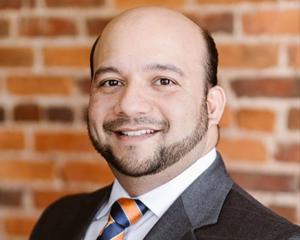Following the anniversary of the launch of ChatGPT, the Harbert College of Business
interviewed Asim Ali to find out how generative AI is impacting instruction and student
performance at Auburn and how he and his organization are leading the adoption and
powerful application of what he calls “the transformative technology of our time.”
When it was released, ChatGPT upended the world of higher education in ways many found threatening. Fears ran rampant
that students would use the free generative AI tool to create text and video footage
when taking tests and completing assignments rather than “doing it themselves.” A
plethora of AI detection tools quickly popped up across the market, but they were
soon found to fall well short of their claims to eradicate the widespread “cheating”
predicted.
This is fundamentally the wrong way to look at generative AI, according to Ali, executive director of the Biggio Center at Auburn University and a lecturer in the Harbert College of Business. Ali plays a leading role in helping Auburn faculty and instructors understand and
implement AI in their teaching.
| Question: |
Let’s start with the defensive posture many in higher ed took early on when it comes
to generative AI. Why did you and Auburn go in the exact opposite direction?
|
| Ali: |
To begin with, it wasn’t all that surprising to see many predict doom and gloom for
higher ed upon the introduction of a major technological development with critical
bearing on instruction and student learning. We saw this with online learning a decade
ago. Higher ed has typically been a laggard when it comes to leveraging the benefits
of new technology in the classroom – skeptical, hesitant, slow to adopt.
But it doesn’t have to be that way, and it certainly isn’t at Auburn. We moved strategically
when it came to online instruction, and we are leading the University down a similar
path with generative AI – embrace, invest and share the expertise and tools we develop
for use by all.
|
| Question: |
What has Auburn done when it comes to online instruction and how does it relate to
incorporating AI?
|
| Ali: |
Our experience with online instruction at Auburn started out like those at many other
institutions – we enlisted an online program management (OPM) firm to help drive our
efforts. In our case, we soon found out that external approaches to OPM simply didn’t
meet Auburn’s high standards for instruction and faculty and student support. So,
we took the mission back in-house. That decision has proven to be the right one, resulting
in Auburn now having one of the most robust and effective online higher education
programs in the world today.
With generative AI, we moved much more quickly to embrace the value this new technology
offers and developed a set of guidelines, assignment and testing examples and case
studies for incorporating generative AI into both faculty preparation as well as student-focused
learning initiatives. And we’ve offered those assets to other universities throughout the Southeastern Conference and across the nation.
|
| Question: |
You’ve called generative AI “the transformative technology of our time.” What do you mean by that?
|
| Ali: |
We need to step back a bit to look at the impact of new technologies on processes
and best practices in business and industry. After all, higher education is a multi-billion-dollar
industry with financial limitations and inefficiencies in need of viable, effective
solutions – just like any other industry. And recognize that the most impactful new
solutions are those that save both time and money while improving outcomes delivered.
That’s particularly important in labor-intensive industries like higher ed – it's
impossible to deliver high quality learning and run an elite university without people.
And the thing those people value most is time – how can AI or any other new technology
help me do things not only better, but faster as well? The more time saved by not doing repetitive tasks the more time faculty
have for world-class research and personalized, effective teaching.
|
| Question: |
Can you give us an example of how AI can help save time for faculty while also improving
the quality of instruction when it comes to student outcomes?
|
| Ali: |
Yes, and it is important to note that saving time for faculty and driving optimal
student outcomes go hand in hand – they are not mutually exclusive. Quite the contrary.
I teach an Introduction to Information Systems course at the Harbert College of Business where we have about 130 students from a
wide variety of different majors – marketing, finance, accounting, supply chain management,
business analytics, etc. So, if I try to teach a key concept in an overly generic
way, I'm going to lose some students depending on the watered-down examples I would
have to use. Nobody ends up feeling that those examples apply to their individual
major and post-graduation professional plans. Relevance is lost.
But using ChatGPT, I can create potential examples or case studies covering a particular
concept and ask the tool to tailor the responses it returns based on elements of each
student’s major. This allows me to personalize the learning a little bit more by major.
Just like advanced radar technology used by the Weather Channel brings us hyper-localized
weather forecasts right down to the street we each live on, generative AI technology
can help us give our students a hyper-personalized learning experience.
|
| Question: |
As with the adoption of many new technologies, some argue AI can contribute to the
existing have-and-have-not disparity of access to education – that those adept at
using AI will gain an advantage over those who aren’t. What’s your take?
|
| Ali: |
Generative AI will absolutely benefit those who learn how to use it over those who
don’t – that’s exactly why it is imperative that we, as educators, embrace AI everywhere
and in every way we can. You’d effectively be creating inequity in your class by pretending
that the technology doesn't exist. Not only do our students demand it, but those who
will employ our students demand it as well.
In the end, I want my students to be the most technologically ready when they go in
for that job interview, when they go in for that internship. I want them to stand
out above all their peers in terms of their readiness to use the most transformative
technology of our time. And it turns out that generative AI acts as an equalizer of
sorts. A recent study by Harvard Business School in partnership with the Boston Consulting Group discovered that not only did GPT4 – the latest version of the ChatGPT tool – improve
work quality, the amount of work performed and the speed with which it was performed,
but those designated as the lowest performers in the three groups assembled for testing
showed the biggest gains from using AI.
Let me repeat – the lowest performers received the greatest benefit from using AI That’s quite remarkable, really.
|
Question:
|
What does that mean for employers looking to hire college graduates to work in what
is becoming an increasingly AI-driven world?
|
| Ali: |
That’s the kicker, really. Incorporating AI into higher education is having an even
greater impact outside the classroom, in the world of business and industry. We're seeing a clear distinction
emerging between the haves and the have nots in business based on which companies
take the time to develop a sound hiring policy when it comes to AI and those that
don’t.
Why? The short answer is that employers can now hire from a broader pool of diverse
talent, with one key equalizer being the candidates’ familiarity with using AI as
a critical business tool.
The longer answer is that, just like we decided a decade ago that online learning
needed to become a fundamental component of Auburn’s higher education portfolio, generative
AI needs to be an essential element of our educational and career readiness missions
as well.
Again, the advantage we seek for our students and partners in industry is differentiation – we want our students and graduates to stand out based on their skills, expertise
and experience, including AI. That’s not something you can outsource to third parties.
It must be core to the Auburn vision.
That’s why we do what we do.
|
The Expert Answers Q+A reflect the expertise and opinions of individual faculty members
and do not necessarily represent an official policy or position of the university.
###
The Auburn University Biggio Center for the Enhancement of Teaching and Learning has introduced a world-class, fully-online, self-paced course, "Teaching with AI," designed for higher education faculty, graduate students interested in academic careers
and professional staff. The course has been adopted by the Southeastern Conference for use at its 14 institutions, as well as by over
50 other institutions, and has been featured in The Chronicle of Higher Education
and Inside Higher Ed.
The Harbert College of Business which is celebrating the 10th anniversary of Raymond and Kathryn Harbert's transformational naming gift, is a nationally ranked
hub of undergraduate, graduate and continuing business education that is inspiring
the next generation of business leaders. Our world-class faculty deliver unparalleled
academic rigor in the classroom, while our research-driven scholarship advances thought
leadership and best practice across business disciplines. The largest college on Auburn's
campus, Harbert enrolls more than 6,900 undergraduate, graduate and doctoral students.

 Degrees & Programs
Degrees & Programs
 Faculty & Staff
Faculty & Staff
 Career Development
Career Development
 Recruiters & Industry
Recruiters & Industry



